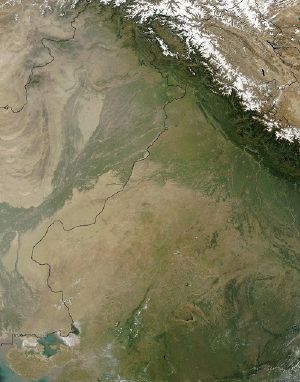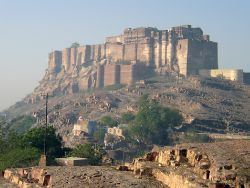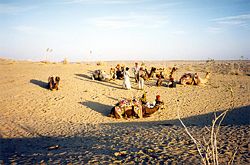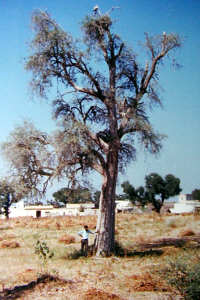Thar Desert

The Thar Desert, also known as the Great Indian Desert, encompasses 77,000 square miles of rolling sand dunes in Pakistan and the Indian state of Rajasthan. Small portions of the desert also extend into the Indian states of Haryana. Punjab, and Gujarat, but these states do not excercise extensive control over the region. The Thar Desert is defined by a serious of natural borders, including the Aravalli Monutain Range to the sutheast and the Punjab plain in the north and northeast. To the west lies the Indus plain, and to the south the Rann of Kutch. The geographic isolation of the Thar Desert by mountain ranges and plains contributes significantly to the weather patterns that shape its distinctive hot dry environment. The environemnt around the Thar effectively absorbs all the rain that is carried in the monsoon clouds before the clouds can reach the desert. The resulting monsoon winds in teh desert are hot and dry, and the desert does not share in the wet season experienced in surrounding terrains.
Geography
Natural Features
The Thar Desert is distinguished by a series of rolling sand dunes, that vary in height across the desert. While sand dunes are a common occurance in deserts across the world, the dunes of the Thar are remarkable for their continnual motion. In sharp contrast to the mountian ranges that ring the desert, the sandy desert floor is always in motion. The purpetual movement of the desert, while contributing the the desert's beauty, has had a prohibitive effect for permanent human settlement, as the sands can easily be blown over structures. The sands are particularly mobile due to severe winds in the region, that sweep the sands over areas of fertile soil. The layer of sand over much of the available farming land hinders agricultural development in the region. Some of the sand dunes of the Thar have become semistabilized over time, and while not completely sedentary, these older dunes only move very small degrees. Older sand dunes can reach a height of 500 feet.
Dotted among the sands of the Thar, several salt water lakes provide a unique and welcome environment for desert dwelling creatures. While the contents of the lakes cannot be directly drunk by humans, the area provide much needed shelter and viable farmland. The abundance of salt water, however, also serves to highlight the extreme lack of drinkable water in the Thar Desert. Annual rainfall in the region is particularly low, measuring from 4-20 inches, most of which falls during the monsoon season. It is difficult to estimate annual precipitation for the Thar Desert however, as rainfall often varies wildly from year to year.
Vegetation
The harsh natural environment and extreme temapture variations found in the Thar Desert have combined to severely inhibit the growth of vegetation. Most of the native plants grow in small clumps, without a system of order regulating where the clumps grow or any standard number of plants in a vegetation grouping. The plants which have been most successful in the difficult environment have adapted to the conditions of the desert. It is important in particular for plants to hav e delevloped water shortage systems to be able to provide much needed water to themselves during the dry season. Significant plants of the desert include gum arabic acacia and euphorbia. However, these plants are only found on the rocky slopes of the hills.
Permanent solution to this problem of shifting sand dunes can be provided by fixation of the shifting sand dunes with suitable plant species and planting windbreaks and shelterbelts. They also provide protection from hot or cold and desiccating winds and the invasion of sand.
The local tree species for planting in the desert region are not many and they are also very slow growing. The introduction of exotic tree species in the desert for plantation has become necessary. Many species of Eucalyptus, Acacia, Cassia and other genera have been tried from Israel, Australia, USA, Russia, Southern Rhodesia, Chile, Peru, Sudan etc. in Thar Desert Acacia tortilis has proved to be the most promising species for desert afforestation and has helped in checking the spread of desert soils to other areas and fixing of sand dunes. The jojoba is one other promising species of economic value found suitable for planting in these areas.
The Rajasthan Canal system is the major irrigation scheme of the Thar Desert and is conceived to reclaim it and also to check spreading of the desert to fertile areas.The river Luni is the only natural water source that drains inside a lake in the desert.
Wildlife

Stretches of sand in the desert are interspersed by hillocks and sandy and gravel plains. Due to the diversified habitat, the vegetation and animal life in this arid region is very rich. About 23 species of lizard and 25 species of snakes are found here and several of them are endemic to the region.
Some wildlife species, which are fast vanishing in other parts of India, are found in the desert in large numbers such as the Great Indian Bustard (Ardeotis nigriceps), the Blackbuck (Antilope cervicapra), the Indian Gazelle (Gazella bennettii) and the Indian Wild Ass (Equus hemionus khur) in the Rann of Kutch. How these animals and insects survive in these harsh conditions, under such high temperature and without drinking water and green vegetation are amazing. They have evolved excellent survival strategies, their size is smaller than other similar animals living in different conditions, and they are mainly nocturnal. There are certain other factors responsible for the survival of these animals in the desert. Due to the lack of water in this region, transformation of the grasslands into cropland has been very slow. The protection provided to them by a local community, the Bishnois, is also a factor.
The Desert National Park, Jaisalmer, spread over an area of 3162 km², is an excellent example of the ecosystem of the Thar Desert, and its diverse fauna. Great Indian Bustard, Blackbuck, chinkara, desert fox, Bengal fox, wolf, desert cat etc. can be easily seen here. Seashells and massive fossilized tree trunks in this park record the geological history of the desert. The region is a haven for migratory and resident birds of the desert. One can see many eagles, harriers, falcons, buzzards, kestrel and vultures. Short-toed Eagles (Circaetus gallicus), Tawny Eagles (Aquila rapax), Spotted Eagles (Aquila clanga), Laggar Falcons (Falco jugger) and kestrels are the commonest of these.
Tal Chhapar Sanctuary is a very small sanctuary in Churu District, 210 km from Jaipur, in the Shekhawati region. This sanctuary is home to a large population of graceful Blackbuck. Desert Fox and desert cat can also be spotted along with typical avifauna such as partridge and sand grouse.
History and Peoples
The origin of the Thar Desert is a controversial subject. Some consider it to be 4000 to 10,000 years old, whereas others state that aridity started in this region much earlier. Another theory states that area turned to desert relatively recently: perhaps around 2000 - 1500 B.C.E. Around this time the Ghaggar ceased to be a major river. It now terminates in the desert. It has been observed through remote sensing techniques that Late Quaternary climatic changes and neotectonics have played a significant role in modifying the drainage courses in this part and a large number of palaeochannels exist.
Most of the studies share the opinion that the palaeochannels of the Sarasvati coincide with the bed of present day Ghaggar and believe that the Sutlej along with the Yamuna once flowed into the present Ghaggar riverbed. It has been postulated that the Sutlej was the main tributary of the Ghaggar and that subsequently the tectonic movements might have forced the Sutlej westwards, the Yamuna eastwards and thus dried up the Ghaggar.
The main occupation of the people in desert is agriculture and animal husbandry. In past years there has been a tremendous increase in human population as well as animal population. This has led to improper control of grazing and extensive cultivation resulting into the deterioration of vegetation resources. The increase of human and livestock population in the desert has lead to deterioration in the ecosystem resulting in degradation of soil fertility. The living standard of the people in the desert is low.
Jodhpur, the largest city in the region, lies in the scrub forest zone. Bikaner and Jaisalmer are located in the desert proper.
A large irrigation and power project has reclaimed areas of the northern and western desert for agriculture. The small population is mostly pastoral, and hide and wool industries are prominent.
The Indian Desert is mainly inhabited by Hindus, Muslims, and Sikhs. The portion in Pakistan is inhabited by primarily by Sindhis and Kolhis. There are around 60% Muslims and 40% Hindus in the Pakistani part of the Thar Desert. A colorful culture rich in tradition prevails in the desert. The people have a great passion for music and poetry.
Desert economy
Agriculture
The main occupation of people in desert is agriculture and animal husbandry. Agriculture is not a dependable proposition in this area— after the rainy season, at least 33% of crops definitely fail. Animal husbandry, trees and grasses, intercropped with vegetables or fruit trees, is the most viable model for arid, drought-prone regions. Arid regions of Western Rajasthan, Gujarat, and Southern parts of Haryana receive low precipitation (under 40 CMS. normally) with high evapotranspiration due to high solar radiation and wind speed. The region faces frequent droughts. Overgrazing due to the high animal population, wind and water erosion, mining and other industries are serious land degradation processes.[1]
Livestock
In the last 15-20 years, the Rajasthan desert has seen many changes, including a manifold increase of both the human and animal population. Animal husbandry has become popular due to the difficult farming conditions. At present, there are ten times more animals per person in Rajasthan than the national average, and overgrazing is also a factor affecting climatic and drought conditions.
Agro-forestry
Forestry has an important part to play in the amelioration of the conditions in semi-arid and arid lands. If properly planned forestry can make an important contribution to the general welfare of the people living in desert areas. The living standard of the people in the desert is low. They can not afford other fuels like gas, kerosene etc. Fire wood is their main fuel, of the total consumption of wood about 75 percent is firewood. The forest cover in desert is low. The forest is insufficient to fulfill the need of firewood. This diverts the much needed cattledung from the field to the hearth. This in turn results into the decrease in agricultural production.
The scientists of Central Arid Zone Research Institute,Jodhpur (CAZRI), have successfully developed and improved dozens of traditional and non-traditional crops/fruits, such as Ber trees (like plums) that produce much larger fruits than before (lemon-size) and can thrive with minimal rainfall. These trees have become a profitable option for farmers. One example from a case study of horticulture showed that in situation of budding in 35 plants of Ber and Guar (Gola, Seb & Mundia variety developed in CAZRI), using only one hectare of land, yielded 10,000 kg. of Ber and 250 kg. of Guar, which translates into double or even triple profit.[2]
The most important tree species, in Agro-forestry , providing livelihood support in Thar desert is Prosopis cineraria.
Prosopis cineraria provides wood of construction class. It is used for house-building, chiefly as rafters, posts scantlings, doors and windows, and for well construction water pipes, upright posts of Persian wheels, agricultural implements and shafts, spokes, fellows and yoke of carts. It can also be used for small turning work and tool-handles. Container manufacturing is another important wood based industry, which depends heavily on desert grown trees.
Prosopis cineraria is much valued as a fodder tree. The trees are heavily lopped particularly during winter months when no other green fodder is available in the dry tracts. There is a popular saying that death will not visit a man, even at the time of a famine, if he has a Prosopis cineraria, a goat and a camel, since the three together are some what said to sustain a man even under the most trying condition. The forage yield per tree varies a great deal. On an average, the yield of green forage from a full grown tree is expected to be about 60 kg with complete lopping having only the central leading shoot, 30 kg when the lower two third crown is lopped and 20 kg when the lower one third crown is lopped. The leaves are of high nutritive value. Feeding of the leaves during winter when no other green fodder is generally available in rain-fed areas is thus profitable. The pods are a sweetish pulp and are also used as fodder for livestock.
Prosopis cineraria is most important top feed species providing nutritious and highly palatable green as well as dry fodder, which is readily eaten by camels, cattle, sheep and goats, constituting a major feed requirement of desert livestock. Locally it is called Loong. Pods are locally called sangar or sangri. The dried pods locally called Kho-Kha are eaten. Dried pods also form rich animal feed, which is liked by all livestock. Green pods also form rich animal feed, which is liked by drying the young boiled pods. They are also used as famine food and known even to prehistoric man. Even the bark, having an astringent bitter taste, was reportedly eaten during the severe famine of 1899 and 1939. Pod yield is nearly 1.4 quintals of pods/ha with a variation of 10.7% in dry locations.
Prosopis cineraria wood is reported to contain high calorific value and provide high quality fuel wood. The lopped branches are good as fencing material.
Tecomella undulata is tree species, locally known as Rohida, found in Thar Desert regions of northwest and western India, is another important medium sized tree of great use in Agro-forestry, that produces quality timber and is the main source of timber amongst the indigenous tree species of desert regions. The trade name of the tree species is Desert teak or Marwar teak.
Tecomella undulata is mainly used as a source of timber. Its wood is strong, tough and durable. It takes a fine finish. Heartwood contains quinoid. The wood is excellent for firewood and charcoal. Cattle and goats eat leaves of the tree. Camels, goats and sheep consume flowers and pods.
Tecomella undulata plays an important role in environmental conservation. It acts as a soil-binding tree by spreading a network of lateral roots on the top surface of the soil. It acts as a windbreak and helps in stabilizing shifting sand dunes. It is considered as the home of birds and provides shelter for other desert wildlife. Shade of tree crown is shelter for the cattle, goats and sheep during summer days.
Tecomella undulata has got medicinal properties as well. The bark obtained from the stem is used as a remedy for syphilis. It is also used in curing urinary disorders, enlargement of spleen, gonorrhoea, leucoderma and liver diseases. Seeds are used against abscess.
Notes
Sources and Further Reading
- Kaul, R. N. 1970. Afforestation in arid zones. Monographiae biologicae, v. 20. The Hague: Junk.
- Gupta, Raj Kumar, and Ishwar Prakash. 1975. Environmental analysis of the Thar Desert. Dehra Dun: English Book Depot.
- Indian Academy of Sciences. 1934. Proceedings of the Indian Academy of Sciences. Bangalore City: Indian Academy of Sciences. V. 89, No. 3, pp. 317-331.
- Geological Society of India. 1959. Journal of the Geological Society of India. Bangalore: Geological Society of India. Vol. 21, pp. 461-463.
- Radhakrishna, B. P., and S. S. Merh. 1999. Vedic Sarasvati: evolutionary history of a lost river of northwestern India. Bangalore: Geological Society of India. ISBN 8185867356 and ISBN 9788185867359
- Radhakrishna, B. P., and S. S. Merh. 1999. Vedic Sarasvati: evolutionary history of a lost river of northwestern India. Bangalore: Geological Society of India. ISBN 8185867356 and ISBN 9788185867359
- Kaul, R.N. (1967). Trees or grass lands in the Rajasthan- Old problems and New approaches. Indian Forester, 93: 434-435.
- Burdak, L.R. (1982). Recent Advances in Desert Afforestation- Dissertation submitted to Shri R.N. Kaul, Director, Forestry Research, F.R.I., Dehra dun.
- Bakliwal, P.C. and Grover, A.K. (1988). Signature and migration of Sarasvati river in Thar desert, Western India. Record of the Geological Survey of India. V 116, Pts. 3-8, pp. 77-86.
- Rajesh Kumar, M., Rajawat, A.S. and Singh, T.N. (2005). Applications of remote sensing for educidate the Palaeochannels in an extended Thar desert, Western Rajasthan, 8th annual International conference, Map India 2005, New Delhi.
- Govt. of India. Ministry of Food & Agriculture booklet. (1965)- soil conservation in the Rajasthan Desert- Work of the Desert Afforestation Research station, Jodhpur.
External links
- Thar Desert. World Wildlife. Retrieved April 28, 2007.
- Jaisalmer, Jodhpur and the Thar Desert. Travel Tips, Flights and Photos. Retrieved April 28, 2007.
- Ahmed, Munir. Thar — Pakistan’s largest desert of living traditions. Travel-Culture. Retrieved April 28, 2007.
- Jaisalmer the Glory of the Golden Fort. Desert Vision. Retrieved April 28, 2007.
| Deserts |
|---|
| Ad-Dahna | Alvord | Arabian | Aral Karakum | Atacama | Baja California | Barsuki | Betpak-Dala | Chalbi | Chihuahuan | Dasht-e Kavir | Dasht-e Lut | Dasht-e Margoh | Dasht-e Naomid | Gibson | Gobi | Great Basin | Great Sandy Desert | Great Victoria Desert | Kalahari | Karakum | Kyzylkum | Little Sandy Desert | Mojave | Namib | Nefud | Negev | Nubian | Ordos | Owyhee | Qaidam | Registan | Rub' al Khali | Ryn-Peski | Sahara | Saryesik-Atyrau | Sechura | Simpson | Sonoran | Strzelecki | Syrian | Taklamakan | Tanami | Thar | Tihamah | Ustyurt |
Credits
New World Encyclopedia writers and editors rewrote and completed the Wikipedia article in accordance with New World Encyclopedia standards. This article abides by terms of the Creative Commons CC-by-sa 3.0 License (CC-by-sa), which may be used and disseminated with proper attribution. Credit is due under the terms of this license that can reference both the New World Encyclopedia contributors and the selfless volunteer contributors of the Wikimedia Foundation. To cite this article click here for a list of acceptable citing formats.The history of earlier contributions by wikipedians is accessible to researchers here:
The history of this article since it was imported to New World Encyclopedia:
Note: Some restrictions may apply to use of individual images which are separately licensed.



